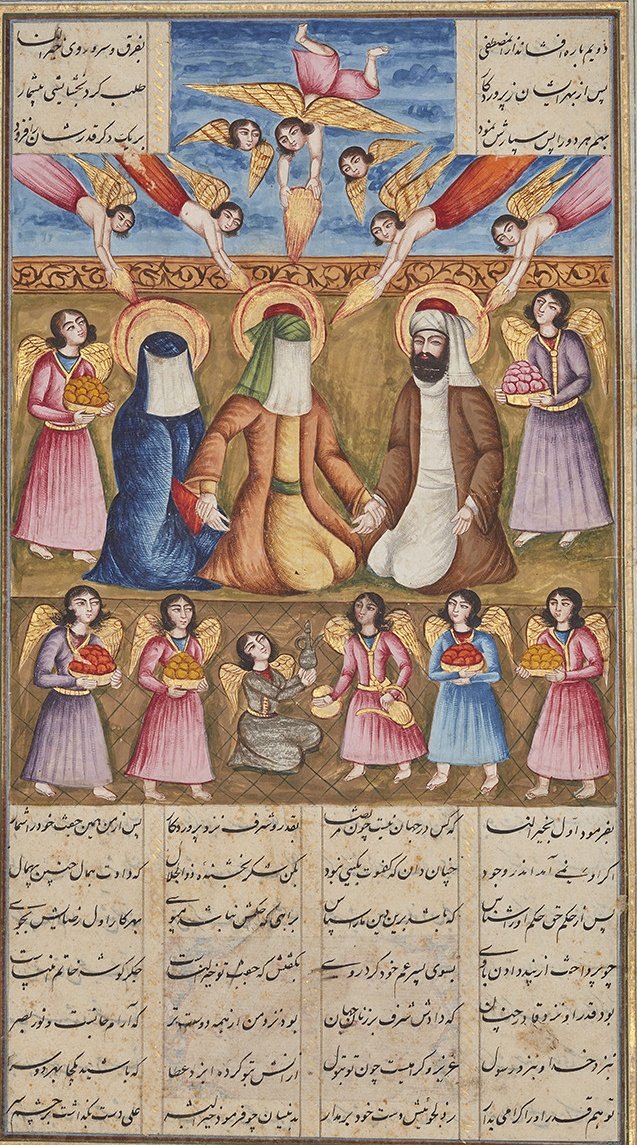[GUEST ACCESS MODE: Data is scrambled or limited to provide examples. Make requests using your API key to unlock full data. Check https://lunarcrush.ai/auth for authentication information.]  MENA Visuals [@menavisualss](/creator/twitter/menavisualss) on x 153.1K followers Created: 2025-07-21 19:17:01 UTC The Marriage of 'Ali and Fatima" Iran, ca. 1850 Materials: Opaque watercolour, ink, and gold on paper This painting is said to depict the marriage of ‘Ali and Fatima, cousin and daughter, respectively, of the Prophet Muhammad. It comes from an as-yet-unidentified text focusing on the life and achievements of ‘Ali, who was the fourth caliph to lead the Muslim community. The text on the reverse describes some of the battles fought by him alongside the Prophet Muhammad. ‘Ali, a cousin of the Prophet Muhammad, and Fatima, a daughter of the Prophet to whom ‘Ali was married, are among the most highly venerated of the Muslim figures, revered for their unwavering faith and role in spreading the belief to new devotees. They, along with their sons, Hasan and Husayn, are known as the ahl al-bayt, "the people of the house [of the Prophet]," and hold a particular place of distinction for Shi‘i Muslims, who believe that authority over the community properly descends among Muhammad’s heirs through ‘Ali. This painting, with its image of Muhammad at the centre clasping the hands of ‘Ali, on his left, and Fatima, on his right, visually represents that strength of connection. All three figures are dressed modestly, and their heads are surrounded by haloes to indicate their holy status. In addition, Fatima and Muhammad’s faces are covered by veils. While the earliest surviving paintings portraying Muhammad in manuscripts from the 13th and 14th centuries do not typically shield a direct view of the Prophet, this convention became increasingly common after the early 16th century. It has been suggested that the veil enables a truly spiritual perception of the Prophet, undistracted by a visual form, to occur. The trio is surrounded by angels bearing fruits and other offerings to celebrate the union.  XXXXXX engagements  **Related Topics** [ink](/topic/ink) [iran](/topic/iran) [Post Link](https://x.com/menavisualss/status/1947375280097554652)
[GUEST ACCESS MODE: Data is scrambled or limited to provide examples. Make requests using your API key to unlock full data. Check https://lunarcrush.ai/auth for authentication information.]
 MENA Visuals @menavisualss on x 153.1K followers
Created: 2025-07-21 19:17:01 UTC
MENA Visuals @menavisualss on x 153.1K followers
Created: 2025-07-21 19:17:01 UTC
The Marriage of 'Ali and Fatima" Iran, ca. 1850
Materials: Opaque watercolour, ink, and gold on paper
This painting is said to depict the marriage of ‘Ali and Fatima, cousin and daughter, respectively, of the Prophet Muhammad. It comes from an as-yet-unidentified text focusing on the life and achievements of ‘Ali, who was the fourth caliph to lead the Muslim community. The text on the reverse describes some of the battles fought by him alongside the Prophet Muhammad.
‘Ali, a cousin of the Prophet Muhammad, and Fatima, a daughter of the Prophet to whom ‘Ali was married, are among the most highly venerated of the Muslim figures, revered for their unwavering faith and role in spreading the belief to new devotees. They, along with their sons, Hasan and Husayn, are known as the ahl al-bayt, "the people of the house [of the Prophet]," and hold a particular place of distinction for Shi‘i Muslims, who believe that authority over the community properly descends among Muhammad’s heirs through ‘Ali. This painting, with its image of Muhammad at the centre clasping the hands of ‘Ali, on his left, and Fatima, on his right, visually represents that strength of connection. All three figures are dressed modestly, and their heads are surrounded by haloes to indicate their holy status. In addition, Fatima and Muhammad’s faces are covered by veils. While the earliest surviving paintings portraying Muhammad in manuscripts from the 13th and 14th centuries do not typically shield a direct view of the Prophet, this convention became increasingly common after the early 16th century. It has been suggested that the veil enables a truly spiritual perception of the Prophet, undistracted by a visual form, to occur. The trio is surrounded by angels bearing fruits and other offerings to celebrate the union.

XXXXXX engagements